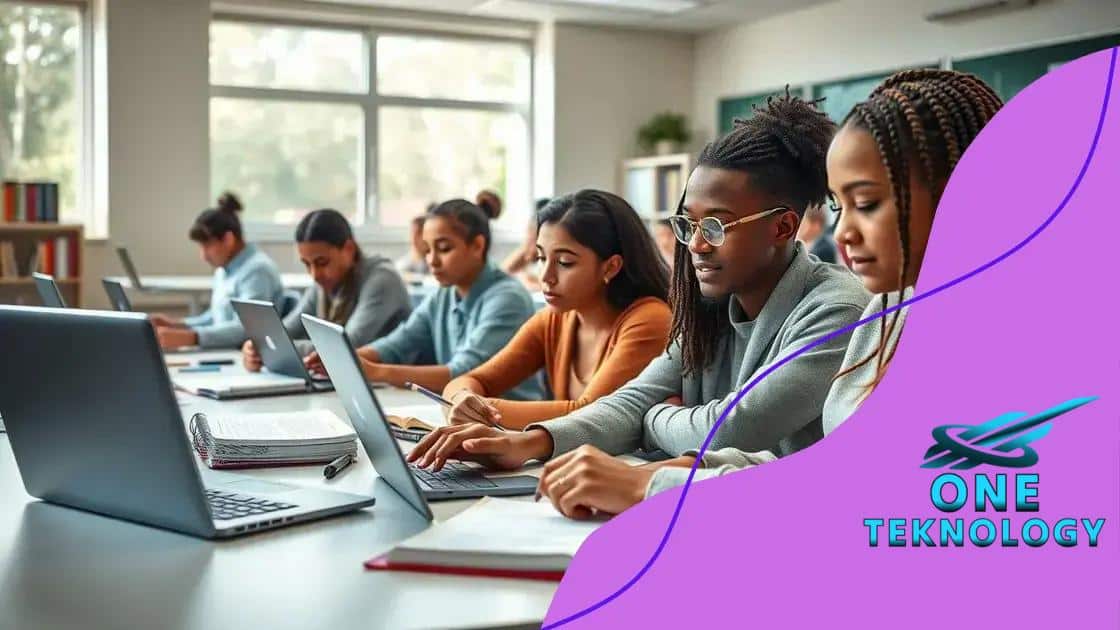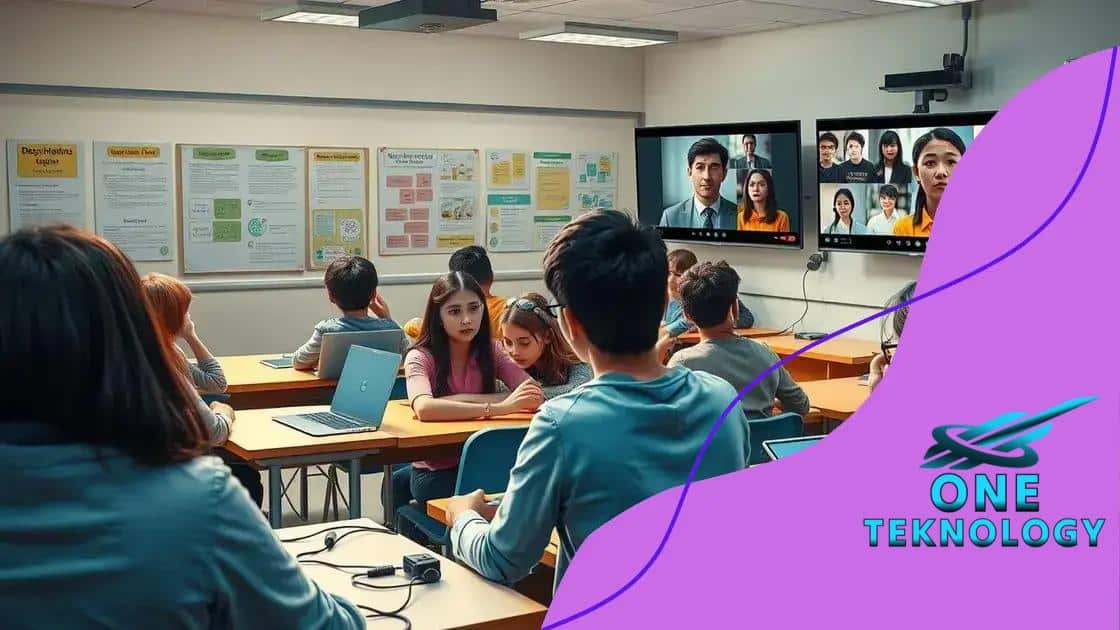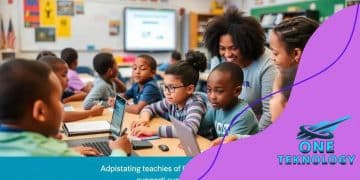The impact of hybrid learning in higher education

The impact of hybrid learning in higher education combines in-person and online classes, enhancing flexibility, engagement, and personalization while addressing challenges such as technology access and maintaining student motivation.
The impact of hybrid learning in higher education is profound, changing how students engage with their studies. Have you thought about how this blend of online and in-person learning affects your educational journey?
Understanding hybrid learning models
Understanding hybrid learning models is essential in today’s educational landscape. This approach combines traditional in-person classes with online components. It offers flexibility and can enhance the learning experience.
What are hybrid learning models?
Hybrid learning models utilize both face-to-face and digital resources. This combination helps cater to different learning styles. Students can interact with instructors and peers in a physical classroom while also accessing online materials.
Benefits of hybrid learning
There are several benefits to adopting hybrid learning:
- Flexibility: Students can learn at their own pace and choose when to attend classes.
- Accessibility: Online components increase access to resources and support for all students.
- Engagement: Students often feel more engaged through interactive online activities.
Another advantage is that hybrid learning can help instructors reach a wider audience. By offering classes online, educators can include students who may not be able to attend in person. This creates a more inclusive environment.
Additionally, hybrid models can enhance critical thinking skills. Students mix self-directed online study with guided classroom discussions. This blend encourages them to take ownership of their learning.
Challenges of hybrid learning
Despite the benefits, there are challenges associated with hybrid learning models. Some students may struggle with the transition from traditional classrooms to online formats. Others might find it hard to stay organized with various learning platforms.
- Technology issues: Not all students have access to reliable internet or devices.
- Self-motivation: Online learning requires a high level of self-discipline.
- Instructor training: Educators need proper training to effectively teach in hybrid environments.
However, with the right support and resources, many of these challenges can be addressed. Understanding hybrid learning models is a step towards adapting education for the future. As institutions continue to explore these methods, they can create more dynamic and fruitful learning experiences for students.
Advantages of hybrid learning for students
Hybrid learning presents several advantages for students, blending the best of online and in-person education. This approach creates a unique learning environment tailored to individual needs.
Flexibility in learning
One of the main benefits of hybrid learning is flexibility. Students can choose when to attend classes and access materials online. This allows them to balance school with other responsibilities.
- Personalized pace: Students can move through the material at their speed, helping them understand complex topics better.
- Access to resources: Online platforms often offer a wealth of resources, from videos to forums for discussion.
- Convenience: Learning can take place anywhere, whether at home, in a library, or on the go.
Moreover, hybrid learning encourages independent study. Students develop self-discipline and time management skills. This independence fosters a sense of ownership over their education, which can increase motivation.
Increased engagement
An interactive learning environment enhances student engagement. When students participate in both face-to-face and online activities, they can share ideas and collaborate more effectively.
- Variety of formats: Different teaching methods cater to varied learning styles, keeping students interested.
- Peer interaction: Collaborating with peers in both settings encourages communication and teamwork skills.
- Access to diverse content: Students can explore numerous resources, broadening their understanding of subjects.
As hybrid learning continues to evolve, it is clear that the advantages for students are significant. They gain not only knowledge from classes but also skills that prepare them for future challenges. This approach creates a more holistic educational experience.
Challenges faced in hybrid learning environments

Hybrid learning environments offer great opportunities, but they also present unique challenges. Understanding these challenges is crucial for both students and educators.
Technological barriers
One major difficulty in hybrid learning is technology access. Not every student has reliable internet or the necessary devices. This can create a gap in learning and participation.
- Device availability: Some students may lack laptops or tablets needed for online classes.
- Internet connectivity: Unstable or slow internet can hinder the ability to join virtual sessions.
- Tech literacy: Not all students are comfortable with using online platforms, which can affect their engagement.
Additionally, navigating different platforms for assignments and lectures can be confusing. Some students may struggle to adapt to various systems, further complicating their learning experience.
Self-motivation and discipline
Another challenge is that hybrid learning requires strong self-motivation. Many students find it difficult to stay engaged without the structure of a traditional classroom.
- Time management: Students must be able to balance both online and in-person commitments.
- Procrastination: With more flexible schedules, some may delay their studies.
- Isolation: The lack of direct interaction can lead to feelings of loneliness, affecting motivation.
This lack of physical presence can make it harder for students to connect with their peers and instructors. Building relationships in a hybrid setting often requires extra effort and intentionality.
Furthermore, instructors face challenges too. They must adapt their teaching strategies to engage students both in-person and online. This dual approach can be demanding and may require more training and resources to be effective.
Best practices for implementing hybrid learning
Implementing hybrid learning effectively involves following certain best practices. These methods help ensure that both students and educators can adapt successfully to this model.
Clear communication
Effective communication is key in hybrid environments. Instructors should be clear about expectations and provide detailed instructions for both online and face-to-face components. Regular updates help keep students informed.
- Use multiple channels: Utilize emails, online platforms, and announcements to reach students.
- Encourage feedback: Create opportunities for students to share their thoughts and concerns.
- Set clear deadlines: Establish specific due dates for assignments and projects to keep everyone on track.
With open lines of communication, students feel more supported and engaged in their learning process.
Engaging content
Another important aspect is to design engaging content. Lessons should be interactive and varied to cater to different learning styles. This keeps students interested and improves retention.
- Incorporate multimedia: Use videos, podcasts, and interactive activities to enhance learning.
- Foster collaboration: Encourage group projects and discussions that include both online and in-person learners.
- Regular assessments: Provide quizzes and activities to gauge understanding and adjust teaching methods accordingly.
By making learning materials dynamic, educators can motivate students to participate actively. A mix of formats fosters deeper understanding and helps maintain attention.
Training and support
Professional development for instructors is crucial. Training sessions should focus on best practices for teaching in a hybrid format. This helps them feel more comfortable using technology and addressing student needs effectively.
- Workshops and tutorials: Offer educational sessions to familiarize educators with online tools and teaching strategies.
- Peer mentoring: Create a mentorship program where experienced instructors support their colleagues.
- Resource sharing: Encourage teachers to share resources and strategies that have worked well in their classes.
When instructors are well-prepared and confident, it positively affects student performance and engagement in hybrid learning environments.
The future of hybrid education
The future of hybrid education looks promising and is rapidly evolving. As technology advances, so do the possibilities for creating dynamic learning environments that blend online and in-person interactions.
Integration of advanced technology
One key aspect of the future will be the integration of advanced technology. Tools like virtual reality (VR) and augmented reality (AR) can enhance the hybrid learning experience. These technologies provide immersive experiences that can make learning more engaging.
- Virtual classrooms: VR can allow students to participate in interactive lessons from anywhere.
- Enhanced simulations: AR can create simulations that deepen understanding of complex subjects, such as science and history.
- AI-driven platforms: Artificial intelligence can be used to personalize learning, adapting resources based on individual student needs.
This use of technology not only enriches the educational experience but also prepares students for a tech-savvy workforce.
Focus on personalization
A growing trend in education is the emphasis on personalized learning. Future hybrid models will likely adapt to the unique needs of each student, offering tailored resources and support. This might include different learning pathways and customized feedback.
- Adaptive learning systems: These systems can track student performance and adjust lessons accordingly.
- Individual learning goals: Students may set personalized objectives, allowing them to progress at their own pace.
- Mentorship opportunities: Pairing students with mentors can provide additional guidance and support.
Such customization can lead to improved outcomes and higher levels of student satisfaction.
Collaboration and community building
The future of hybrid education will also emphasize collaboration and community building. As educational institutions look to create more inclusive environments, building strong communities will be essential.
- Peer learning: Facilitating connections between students can foster teamwork and critical thinking.
- Community involvement: Collaborations with local organizations can enrich the curriculum and expose students to real-world applications.
- Global networking: Online platforms can connect students and educators from different parts of the world, enhancing cultural exchange.
Overall, a focus on collaboration enhances the learning experience and prepares students for a globalized society.
FAQ – Frequently Asked Questions about Hybrid Education
What is hybrid education?
Hybrid education is a learning model that combines traditional in-person classes with online learning components, offering flexibility and accessibility.
How can technology enhance hybrid learning?
Technology can improve hybrid learning through tools like virtual reality, multimedia resources, and online collaboration platforms, making lessons more engaging.
What are some challenges of hybrid learning?
Challenges include access to technology, maintaining student motivation, and ensuring effective communication between instructors and students.
Why is personalized learning important in hybrid education?
Personalized learning tailors educational experiences to individual student needs, improving engagement and academic outcomes in a hybrid setting.






